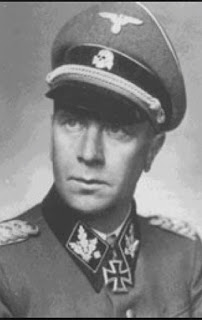 |
| Lt. Gen. Hanns Rauter, SS Commander in Holland |
The truck contained food and SS leader Lt. Gen. Johann Baptist Albin (Hanns) Rauter.
The Resistance group killed all the SS troops on the truck except Gen. Rauter, who was wounded and pretended to be dead. During the week after the ambush, the German SS executed 263 Dutch people in retaliation for the ambush.
The Dutch Resistance was one of the fiercest of all the underground movements in Nazi-occupied Europe. The Dutch foreign minister in a postwar account of life under Nazi occupation wrote:
“The Dutch never accepted the German contention that… the war was over. [T]heir acts of resistance and sabotage grew more audacious as time passed.”Acts of resistance and sabotage included
- Sheltering onderduikers (underdivers), including Allied soldiers and pilots who either parachuted or crash-landed within Dutch territory, Jews in Holland, and men who were ordered to report for transport to Germany to work in the factories.
- Bringing onderduikers out of the Netherlands.
- Killing collaborators and German SS and Wehrmacht troops separated from larger contingents.
- Bombing Nazi sites such a record centers that kept track of people to be deported (and most likely killed by starvation or poison gas).
- Stealing food and coupons and ID cards from SS and police centers.
- Creating counterfeit money that was used to finance Resistance groups.
Gen. Hanns Rauter was head of the SS in Holland and answered directly to Heinrich Himmler, the SS commander. In February 1941, a strike broke out in Amsterdam among Dutch workers to protest the round-up of almost 400 Dutch Jews. Rauter ordered the SS and German troops to open fire on the strikers, killing 11. The Jews, whom the strikers were trying to protect, were deported to Buchenwald and all were dead by the fall.
Under Rauter's guidance, a special block in the Schenevingen prison—nicknamed by the Dutch the Orange Hotel—was built for "political prisoners", i.e., Resistance workers. During the four years of this block, 28,000 people were detained here indefinitely, of whom 738 men and 21 women died here or nearby on the dunes, the Waalsdorpervlakte, where the Cemetery of Heroes is now located.
In his retaliations for assaults on Nazis and collaborators, Rauter equated the death of one Nazi to ten Dutch reprisal executions victims and one killed Dutch collaborator with three Dutch reprisals. During 1944 these numbers sharply increased with the rise of Resistance violence.
In 1945, near the end of the war, Rauter was riding in an SS truck filled with food destined for a Luftwaffe base near Apeldoorn. Young members of the Dutch Resistance ambushed the truck to get the food inside. The "Hunger Winter" of 1944-45 left much of occupied Holland close to famine conditions, and the Resistance group was determined to save lives by seizing the food. They did not know Rauter was in the truck when it was attacked.
After WW2, SS Gen. Rauter was tried for war crimes by the Dutch court in Den Haag. He was found guilty and sentenced to death. He appealed the sentence at Nuremberg in 1949, but the sentence was upheld and he was executed that year. That was the year that my grandmother, Olga Boissevain, who lost both of her sons to the war, died.
Clip of trial is here: https://www.youtube.com/watch?v=-4SzZPjr9Zs
Your facts about Rauter are not true. It wasn't a truck but a BMW convertible.
ReplyDeleteEvery source says it was a truck. Your correction is of no use if you don't provide a source.
ReplyDelete